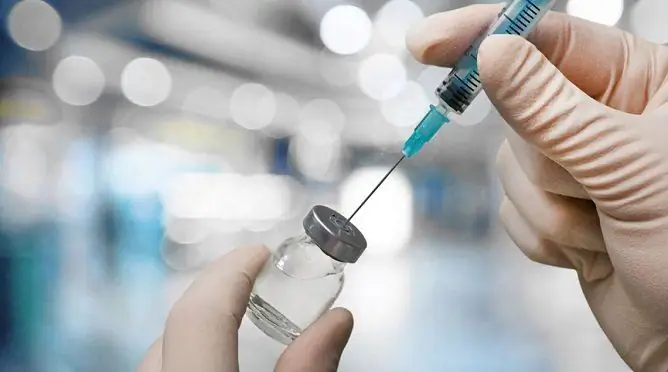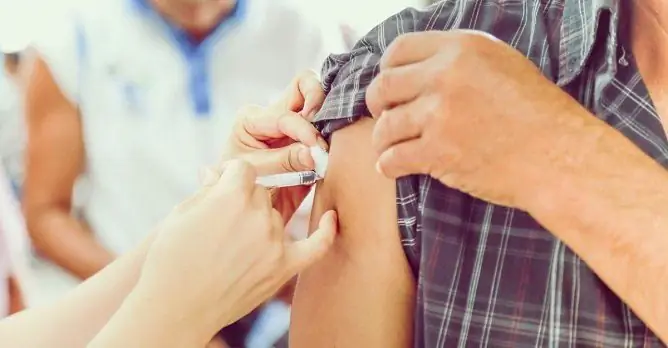- Author Rachel Wainwright [email protected].
- Public 2023-12-15 07:39.
- Last modified 2025-11-02 20:14.
Bubo-Kok
Bubo-Kok: instructions for use and reviews
- 1. Release form and composition
- 2. Pharmacological properties
- 3. Indications for use
- 4. Contraindications
- 5. Method of application and dosage
- 6. Side effects
- 7. Overdose
- 8. Special instructions
- 9. Application during pregnancy and lactation
- 10. Use in childhood
- 11. In case of impaired renal function
- 12. For violations of liver function
- 13. Use in the elderly
- 14. Drug interactions
- 15. Analogs
- 16. Terms and conditions of storage
- 17. Terms of dispensing from pharmacies
- 18. Reviews
- 19. Price in pharmacies
Latin name: Bubo-Kok
ATX code: J07CA05
Active ingredient: diphtheria toxoid (Diphtheria toxoid), tetanus toxoid (Tetanus toxoid), pertussis bacteria (Pertussis bacteria), HBsAg (HBS-protein - the main surface antigen of the hepatitis B virus) [HBsAg (HBS-interdum est conseiectetur of superpatitis virus)]
Producer: Kombiotech NPK, CJSC (Russia)
Description and photo update: 2019-11-07

Bubo-Kok is a medical immunobiological drug (MIBP), a combined vaccine for the prevention of hepatitis B, tetanus, diphtheria and whooping cough.
Release form and composition
Dosage form - suspension for intramuscular (i / m) administration: homogeneous, yellowish-white; during storage, it is divided into two layers - a colorless transparent liquid and a friable yellowish-white precipitate, which, when shaken, completely breaks down [0.5 mg (1 dose) in ampoules, 10 ampoules in cell contour packs, in a cardboard box 1 package, ampoule knife and instructions for use of Bubo-Kok (when using ampoules with break points, the ampoule knife is not inserted)].
Composition of Bubo-Kok for 1 dose (0.5 ml):
- active ingredients: diphtheria toxoid - 15 Lf (flocculating units), tetanus toxoid - 5 EC (binding units), pertussis bacteria (Bordetella pertussis) - 10 billion, HBsAg (HBS-protein, which is the main surface antigen of hepatitis B virus) - 5 μg;
- excipients: aluminum hydroxide (Al 3+) - 400 μg, merthiolate (preservative) - 50 μg.
Pharmacological properties
Pharmacodynamics
The composition of Bubo-Kok is a mixture of tetanus and diphtheria toxoids, phase 1 pertussis microbes killed by formaldehyde, and hepatitis B virus recombinant surface antigen (HBsAg) adsorbed on aluminum hydroxide.
When the vaccine is administered according to the approved scheme, specific immunity against tetanus, diphtheria, whooping cough and hepatitis B is formed.
Pharmacokinetics
There is no information on the pharmacokinetics of the drug.
Indications for use
The Bubo-Kok vaccination course is carried out for the prevention of diseases such as whooping cough, diphtheria, tetanus, hepatitis B in children under 4 years of age.
Contraindications
- history of afebrile seizures;
- progressive diseases of the nervous system;
- any acute illness or exacerbation of chronic illness *;
- yeast allergy;
- severe reactions with the introduction or post-vaccination complications after the administration of a previous dose of Bubo-Kok vaccine, hepatitis B vaccine or DTP vaccine.
* Vaccination can be carried out no earlier than 4 weeks after complete recovery or the onset of persistent remission. In milder forms of respiratory diseases (rhinitis, uncomplicated hyperemia of the pharynx, etc.), the Bubo-Kok vaccination can be done 2 weeks after recovery.
Bubo-Kok, instructions for use: method and dosage
Bubo-Kok is administered in accordance with the National Vaccination Schedule. The timing of vaccination should include simultaneous vaccination against tetanus, hepatitis B, diphtheria and pertussis.
The suspension is injected intramuscularly into the upper outer quadrant of the buttocks or the antero-outer region of the thigh. A single dose is 0.5 ml. Before using the drug, the ampoule should be shaken well so that the suspension acquires a homogeneous structure.
Opening the ampoules, filling the syringe and the vaccination procedure must be carried out in strict accordance with the rules of antisepsis and asepsis.
After opening the ampoule, it is prohibited to store the vaccine. Do not use the drug in case of violation of the integrity of the ampoules, lack of labeling, changes in the physical properties of the suspension (discoloration, the presence of unbreakable flakes, etc.), improper storage or expired shelf life.
For children who have not been vaccinated against hepatitis B before the age of 3 months, Bubo-Kok is administered three times: at 3 months, at 4.5 months and at 6 months.
It is impossible to shorten the intervals between drug injections. If it is not possible to get the next vaccination at the set time, the vaccine should be administered as soon as possible, determined by the child's health.
Children who are not vaccinated against hepatitis B, who received one or two vaccinations with the DTP vaccine, the missing number of vaccinations up to three can be carried out with the Bubo-Kok vaccine, while the missing number of vaccines against hepatitis B is given with the corresponding mono vaccine.
With the help of the DPT vaccine, revaccination against whooping cough, diphtheria and tetanus is done once at the age of 18 months (if the terms were violated, then 12-13 months after the end of the full course of vaccination). In cases where revaccination with DTP vaccine coincides in time with the introduction of the hepatitis B vaccine, it can be carried out with the Bubo-Kok vaccine.
The medical representative registers the introduction of the vaccine in the established registration forms, indicating the batch number of the vaccine, its expiration date and manufacturer, the date of vaccination, as well as the nature of the reaction to the introduction of Bubo-Kok.
Note! Children who have not received revaccination with the Bubo-Kok or DPT vaccine before reaching 4 years of age are given ADS-toxoid for the age from 4 years to 5 years 11 months 29 days, or the ADS-M-toxoid vaccine for the age of 6 years. When booster vaccinations for diphtheria and tetanus coincide with the hepatitis B vaccine, it can be given with Bubo-M vaccine.
Side effects
In the first two days after the Bubo-Kok vaccination, short-term local (swelling, hyperemia, soreness) and general (malaise, fever) reactions may occur.
In rare cases, complications may develop: allergic reactions (polymorphic rash, urticaria, angioedema), episodes of a shrill cry, convulsions (usually due to an increase in body temperature).
Overdose
Accidental overdose of the drug is impossible, since 1 ampoule contains 1 inoculation dose.
special instructions
To identify contraindications to vaccination, the attending physician on the day of vaccination must interview the parents and examine the child with mandatory thermometry. Children temporarily exempted from vaccination are monitored for timely immunization.
Due to the risk of developing allergic reactions of an immediate type in especially sensitive children, the child should be under close medical supervision within 30 minutes after the introduction of Bubo-Kok. The vaccination room must be provided with anti-shock therapy.
Stable manifestations of an allergic disease (localized skin manifestations, latent bronchospasm, etc.) are not a reason to refuse vaccination. In this case, the vaccination is done against the background of appropriate therapy.
The development of febrile seizures with the introduction of a previous dose of the vaccine is not a contraindication to the use of Bubo-Kok. However, it is recommended to take paracetamol (10-15 mg / kg 3-4 times a day) within 1-2 days after vaccination.
If the child develops a pronounced general reaction (an increase in body temperature in the first 2 days more than 40 ° C, hyperemia and edema at the injection site with a diameter of more than 8 cm) or a post-vaccination complication, continuation of the vaccination course with Bubo-Kok is contraindicated. If the child has been vaccinated twice, then the course of immunization against tetanus and diphtheria is considered complete, and revaccination against hepatitis B is completed with a single administration of a monovaccine a month after the second Bubo-Kok vaccination. For a child who has received only one vaccination, vaccination is continued with the Bubo-M vaccine and is administered once at least 3 months later. In this case, immunization against hepatitis B ends with a single administration of a monovaccine a month later. In both cases, the first revaccination is carried out with ADS-M-toxoid 9-12 months after the last injection of Bubo-Kok or Bubo-M. If the complication develops after the third Bubo-Kok vaccination, the first revaccination is performed 12-18 months later with ADS-M-toxoid. Subsequent revaccinations make ADS-M toxoid at the prescribed ages.
Information for specialists: the introduction of the vaccine of the current series is stopped if more than 1% of children have an increase in body temperature above 38.5 ° C or more than 4% of the vaccinated have severe local reactions (infiltration more than 2 cm in diameter, swelling of soft tissues with a diameter more than 5 cm). The question of the further use of the vaccine of this series is decided by FGUN GISK im. L. A. Tarasevich.
Application during pregnancy and lactation
Bubo-Kok is used to vaccinate children.
Pediatric use
The Bubo-Kok vaccine is used in children under 4 years of age.
With impaired renal function
For chronic kidney disease, the vaccine can be given at least 4 weeks after achieving stable remission.
For violations of liver function
For chronic liver disease, the vaccine can be given at least 4 weeks after achieving stable remission.
Use in the elderly
Bubo-Kok is used to vaccinate children.
Drug interactions
Bubo-Kok can be administered concurrently with other vaccines provided for in the National Vaccination Schedule, or 1 month after vaccination against other infections.
Allowed to be used in conjunction with antiallergic agents.
Drug interactions with other drugs have not been established.
Analogs
The analogues of Bubo-Kok are Sovigripp and the adsorbed vaccine against whooping cough, diphtheria, tetanus and hepatitis B (DTP-Hep B vaccine).
Terms and conditions of storage
Store and transport at 2-8 ° С (refrigerated, but not frozen). Keep out of the reach of children.
The shelf life is 2.5 years.
Terms of dispensing from pharmacies
It is released only to medical and preventive and sanitary institutions.
Reviews about Bubo-Kok
Bubo-Kok is administered in polyclinics free of charge, the drug is multicomponent and replaces 4 separate vaccinations - these are the main advantages of this vaccine. Some parents indicate that their children tolerated vaccination well, there were no serious adverse reactions, most often there was a slight (up to 37.2 ° C) short-term increase in body temperature.
However, there are many negative reviews about Bubo-Kok, which contain complaints about the poor tolerance of the vaccine. Parents describe the following complications in their children: lethargy, drowsiness, prolonged crying, irritability, tantrums, insomnia, refusal to eat, inflammation at the injection site (in some cases lasting up to a week), as well as an increase in body temperature above 39.5 ° C, which gets lost hard and not for long, but in general lasts up to 5 days.
Price for Bubo-Kok in pharmacies
The vaccine is used as part of the implementation of the National Calendar of Preventive Vaccinations and is supplied to medical institutions, therefore the price for Bubo-Kok is unknown.

Maria Kulkes Medical journalist About the author
Education: First Moscow State Medical University named after I. M. Sechenov, specialty "General Medicine".
Information about the drug is generalized, provided for informational purposes only and does not replace the official instructions. Self-medication is hazardous to health!






